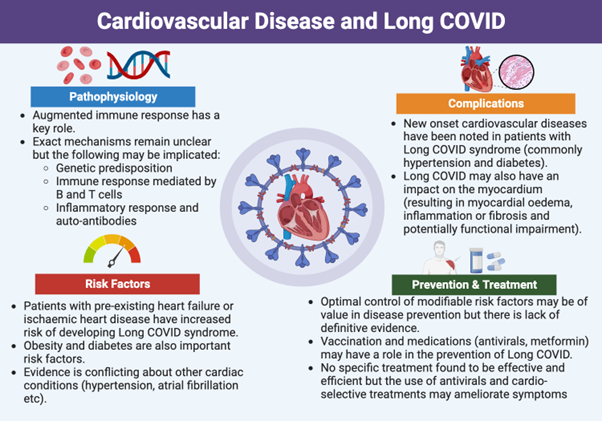Long COVID has been a medical enigma over the last 4 years. The quest to understand its mechanisms, presentation and complications has been turned into a long – and surely educational – journey both for healthcare professionals and the patients. A lot has been elucidated regarding the way in which persistent viraemia, chronic inflammation and underlying co-morbidities may interact with each other and impact people’s quality of life. Yet, many questions remain unanswered and consequently there are still knowledge gaps in the prevention and treatment of Long COVID syndrome.
A systematic review recently published in the European Journal of Preventive Cardiology (EJPC) attempted to review the multifaceted interaction of Long COVID syndrome and the cardiovascular system (figure 1)1. It is widely known that Long COVID may present in many shapes and forms, and it does not spare the heart. On the contrary, the majority of the studies reported cardiac related symptoms in patients with Long COVID, including chest pain, palpitations, breathlessness and syncopal episodes. Whilst in the majority of the cases these symptoms are the whole picture, in some cases there are also pathological findings in cardiac tests such as myocardial inflammation and/or fibrosis as well as impairment of the ventricular function.
Long COVID syndrome and certain cardiovascular diseases (such as heart failure) have some common molecular pathways, for example the cytokine triad of tumour necrosis factor alpha (TNF-a), interleukin-1 (IL-1) and interleukin-6 (IL-6). They also share the common pillar of brewing low-grade chronic systemic inflammation, which is known to play an important role in other cardiovascular diseases such as obesity, diabetes and heart failure. This may partly explain the cardiovascular manifestations of Long COVID syndrome and perhaps why some people – with pre-existing cardiovascular diseases – are more at risk of suffering with lingering symptoms post the acute infection. However, the risk factors of Long COVID are not limited to these diseases so there is definitely more to this than meets the eye2. Perhaps genetic predisposition comes to add a piece to this jigsaw puzzle. Are we genetically vulnerable to certain conditions, including viral infections such as Long COVID? In the era of genetics, evidence-based and personalised medicine, this field has – understandably – attracted attention with conclusive evidence pending.
However, until we get some definitive answers from the ‘genetic front’, we ought to do as much as we can to treat or, better yet, prevent Long COVID and its disabling symptoms. The ‘ugly truth’ is that, if we don’t know what roads the ‘enemy’ uses to attack, we cannot take appropriately adjusted and specific measures for this virus to secure our bodies against it. However, there is a shining light coming from the recent advances in medicine and, more specifically preventive cardiology. We can all apply our already existing knowledge to build a protective shield against this and other infections that may come our way at various timepoints in our life. Healthy lifestyle, comprised of nutrition, exercise and avoidance of harmful habits (such as smoking) helps boost immunity and reduces the inflammation, both important points for the fight against Long COVID. Vaccination is also an important ally for our bodies and it has been proved to be beneficial with vaccinated individuals having almost 50% less risk of Long COVID than the non-vaccinated3. Anti-viral medications, such as nirmatrelvir, have been shown to be promising in reducing the risk of Long COVID syndrome and its associated sequelae4.
The ‘Long COVID journey’ is an evolving and dynamic one, as new variants and new medications come into surface at an exponentially fast rate. As physicians, we should aim to adapt and adjust to this developing field and ensure we provide in the best way the appropriate management plans for prevention, risk stratification and treatment of the patients.

Figure 1. Summary of current knowledge in the connection between Cardiovascular Disease and Long COVID (Reproduced with permission from Tsampasian V et al.1 under a Creative Commons Attribution 4.0 International License).



 Our mission: To reduce the burden of cardiovascular disease.
Our mission: To reduce the burden of cardiovascular disease.